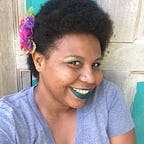why collaborate? why now? why us? why here?
(this text was originally written for the exhibit brochure of Mothers of Creation, 2021 a joint exhibit with Mercy Sabal. presented here with a few edits)
Before i answer any of these questions, let me preface by saying that as a Black non-academic artist who is an art school drop-out with only an associate’s degree, i am not qualified enough to be the authority on anything, much less, answer questions. This very statement will need to be verified by someone whose intelligence you do esteem and value. It is what it is my Belizean people, da soh di ting set since colonialism installed a program called white supremacy in Belize, but not before totally corrupting and eventually deleting all our Indigenous programming. Tragic is a mild descriptor.
i asked Mercy Sabal, an artist who, before Belize attained political independence in 1981, has been making art. More importantly has been making art which demonstrates and highlights Garifunadou and in so doing, preserves the culture.
Pen Cayetano did this by creating Punta Rock in 1978. Benjamin Nicholas’ large paintings showed Garifuna livity around the world. Andy Palacio’s world famous Watina asked the all important Ámuñegü, who will preserve this culture?
These men, among others and a small handful of Garifuna women like the ever illustrious I. Myrtle Palacio, Marcella Lewis and Rosita Baltazar have been acknowledged (far too many remain in complete obscurity because of the colonial nature of culture appreciation in Belize). These few names i listed, have received only a sliver of the respect due them for their massive contributions to the preservation and dissemination of Garifuna culture through their work. Trust me, we can do more.
Also we need to spread that net bigger and give massive respect to all of those doing this important work.
This is why i reached out to Mercy in April of this year. In Garifuna culture, like many Indigenous African and Indigenous cultures, we seek counsel and guidance from our elders. This is how my mother, grandparents, aunts and uncles raised me.
There are so very many things as a Garifuna-(Kriol) Afro-Belizean i prefer because Créole in any language still has a heavy colonial charge, that i want to do to tell our story as the Diasporic Africans in Belize. Still, i have to check in with someone who has been doing it for more years than i’ve even existed.
If there is anything you take away from this exhibit, from this collaboration, i want you to know that society has taught us to dismiss certain folks and movements because they don’t square neatly into what has been socialised to us as *worthy* i want us to liberate ourselves of that. Emancipation started in 1838 in Belize, BIG rispek to all the Belizeans, whose names i know and whose names i do not, who pushed for it, and continue to do so. i see you YaYa Marin Coleman, Evan X Hyde et tal and the whole Zinc Fence. Emancipation continues if we let go of colonised ideals. Emancipation is attained when we are free of those finally.
i ran on and on, but please respect, re-specere, in the Latin origin of that word, look back at, regard, especially those whom you’ve been told to not see any at all.
“R E S P E C T, find out what it means to me!” ~ Aretha Franklin
katie numi usher
June 28, 2021
Ladyville, Belize
